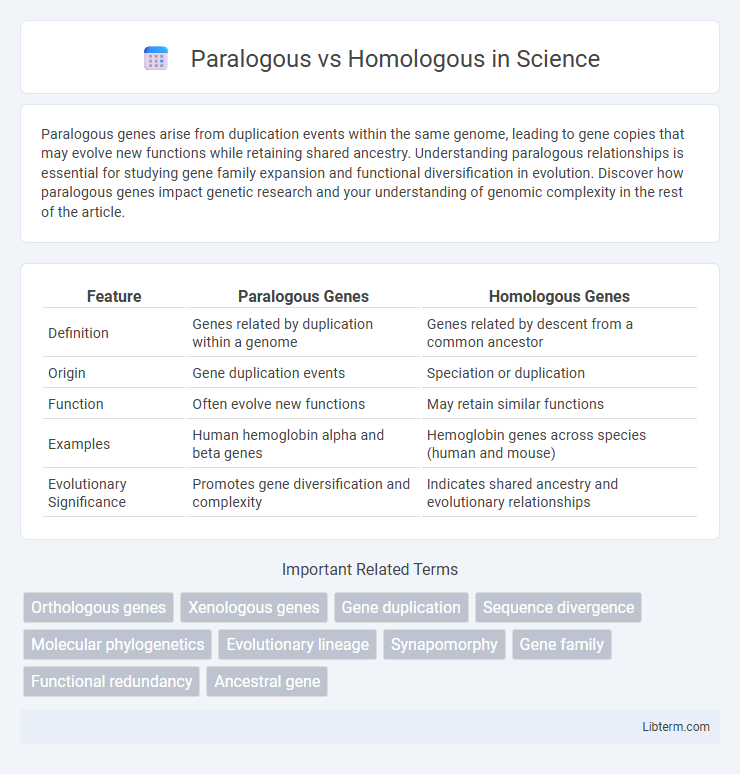Paralogous genes arise from duplication events within the same genome, leading to gene copies that may evolve new functions while retaining shared ancestry. Understanding paralogous relationships is essential for studying gene family expansion and functional diversification in evolution. Discover how paralogous genes impact genetic research and your understanding of genomic complexity in the rest of the article.
Table of Comparison
| Feature | Paralogous Genes | Homologous Genes |
|---|---|---|
| Definition | Genes related by duplication within a genome | Genes related by descent from a common ancestor |
| Origin | Gene duplication events | Speciation or duplication |
| Function | Often evolve new functions | May retain similar functions |
| Examples | Human hemoglobin alpha and beta genes | Hemoglobin genes across species (human and mouse) |
| Evolutionary Significance | Promotes gene diversification and complexity | Indicates shared ancestry and evolutionary relationships |
Introduction to Gene Relationship Concepts
Paralogous genes arise from gene duplication events within the same species, leading to gene copies that may evolve new functions, while homologous genes share a common ancestral gene and include both paralogs and orthologs. Orthologous genes diverge following speciation, maintaining similar functions across species, making gene relationship analysis crucial for understanding evolutionary history and functional genomics. Studying paralogous and homologous relationships enables identification of gene family expansions, functional diversification, and evolutionary conservation in comparative genomics.
Defining Homologous Genes
Homologous genes are sequences in different species that share a common ancestral origin, reflecting evolutionary relationships. These genes can be classified as orthologous when they diverge after a speciation event or paralogous when they result from gene duplication within the same genome. Identifying homologous genes is crucial for studying molecular evolution, functional genomics, and comparative biology.
Understanding Paralogous Genes
Paralogous genes arise from gene duplication events within a single genome, resulting in multiple copies that may evolve new functions while retaining structural similarities. These genes share a common ancestry and often contribute to genetic diversity and complexity in organisms by enabling functional specialization. Understanding paralogous gene relationships is crucial for studying evolutionary biology and gene function diversification.
Homology vs. Paralogy: Key Differences
Homology refers to genes or proteins sharing a common evolutionary ancestor, whereas paralogy specifically describes gene duplication within the same species leading to gene families. Homologous genes include both paralogs, which diverged after duplication events, and orthologs, which diverged after speciation. Key differences lie in their evolutionary origins: homology encompasses all shared ancestry, while paralogy focuses on duplication-related divergence.
Mechanisms of Gene Duplication
Paralogous genes arise through gene duplication events where a single gene is copied within the genome, often due to unequal crossing over or replication slippage, leading to gene families with related but distinct functions. Homologous genes include both paralogs and orthologs, representing shared ancestry either within a species or between species, with orthologs derived from speciation rather than duplication. The primary mechanism generating paralogs involves segmental duplications and whole-genome duplications, which drive genetic innovation and complexity in eukaryotic genomes.
Functional Divergence in Paralogous Genes
Paralogous genes arise from gene duplication events within the same species, often leading to functional divergence as each copy adapts to perform distinct biological roles. This divergence is driven by mutations accumulating over time, allowing paralogs to acquire new functions or specialize in different cellular processes. In contrast, homologous genes include both paralogs and orthologs, with orthologs typically retaining similar functions across species due to speciation events rather than duplication.
Evolutionary Significance of Homologs and Paralogs
Homologous genes arise from a common ancestral gene and are crucial in tracing evolutionary relationships across species, providing insights into gene conservation and divergence over time. Paralogous genes result from gene duplication events within a genome, enabling functional diversification and adaptation by allowing one copy to acquire new functions while the other maintains the original role. These evolutionary processes highlight the importance of homologs in phylogenetic studies and paralogs in molecular innovation and complexity.
Methods for Identifying Homologous and Paralogous Genes
Methods for identifying homologous and paralogous genes primarily rely on sequence similarity searches, such as BLAST, combined with phylogenetic tree reconstruction to distinguish gene relationships. Homologous genes are identified by conserved sequence motifs and structural features, whereas paralogous genes are distinguished through gene duplication events inferred by analyzing gene family expansions in species-specific gene trees. Comparative genomics and synteny analysis further support accurate classification by assessing chromosomal context and evolutionary history.
Biological Implications in Comparative Genomics
Paralogous genes arise from gene duplication events within the same species, contributing to functional diversification and evolutionary innovation, whereas homologous genes include both paralogs and orthologs, reflecting shared ancestry across species. Understanding paralogous versus homologous relationships is crucial in comparative genomics for accurately inferring gene function, evolutionary history, and species phylogeny. Functional annotation and identification of gene families rely heavily on distinguishing paralogs, which can complicate ortholog prediction but provide insights into gene adaptation and specialization.
Conclusion: Importance in Evolutionary Biology
Paralogous genes arise from gene duplication within the same species and often evolve new functions, while homologous genes share a common ancestor but may include both paralogs and orthologs across species. Understanding the distinction between paralogous and homologous genes is crucial for tracing evolutionary relationships and functional diversification. This knowledge provides insights into genome evolution, molecular adaptation, and the origins of biological complexity.
Paralogous Infographic

 libterm.com
libterm.com